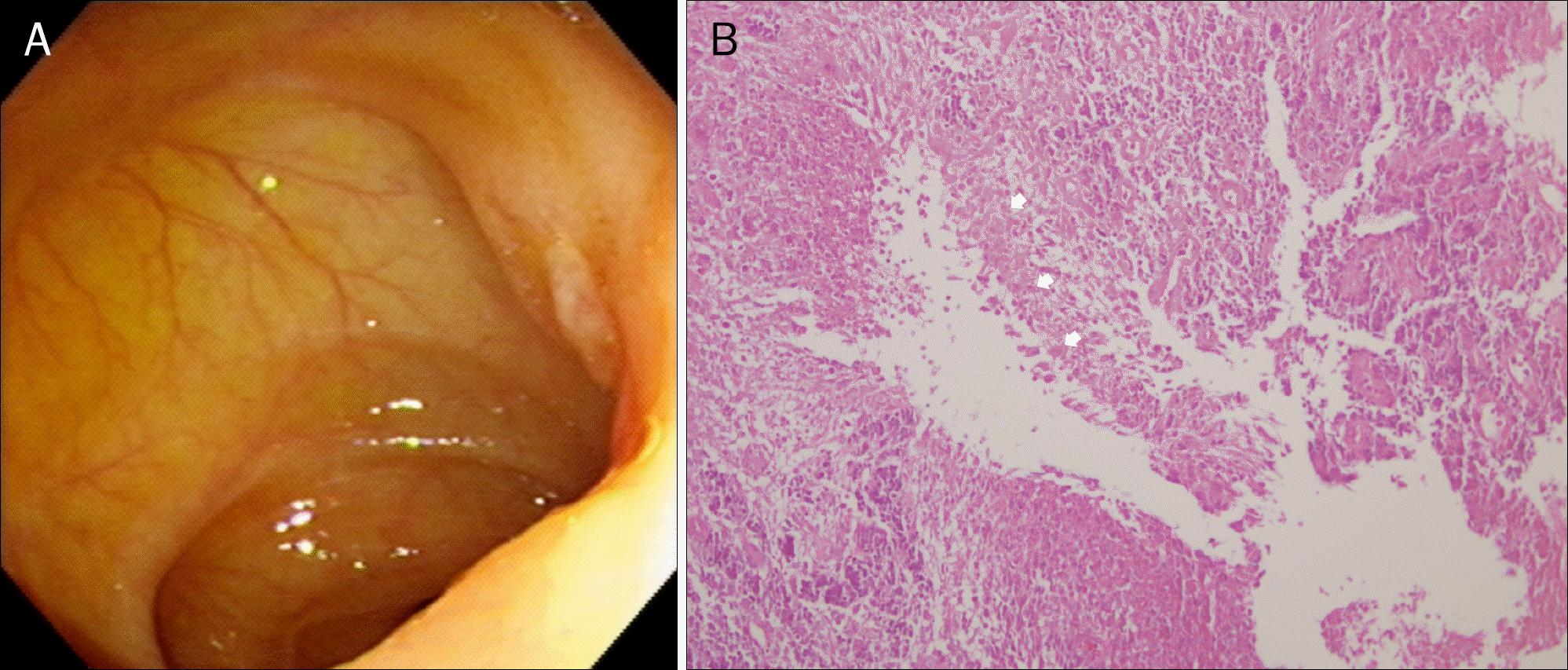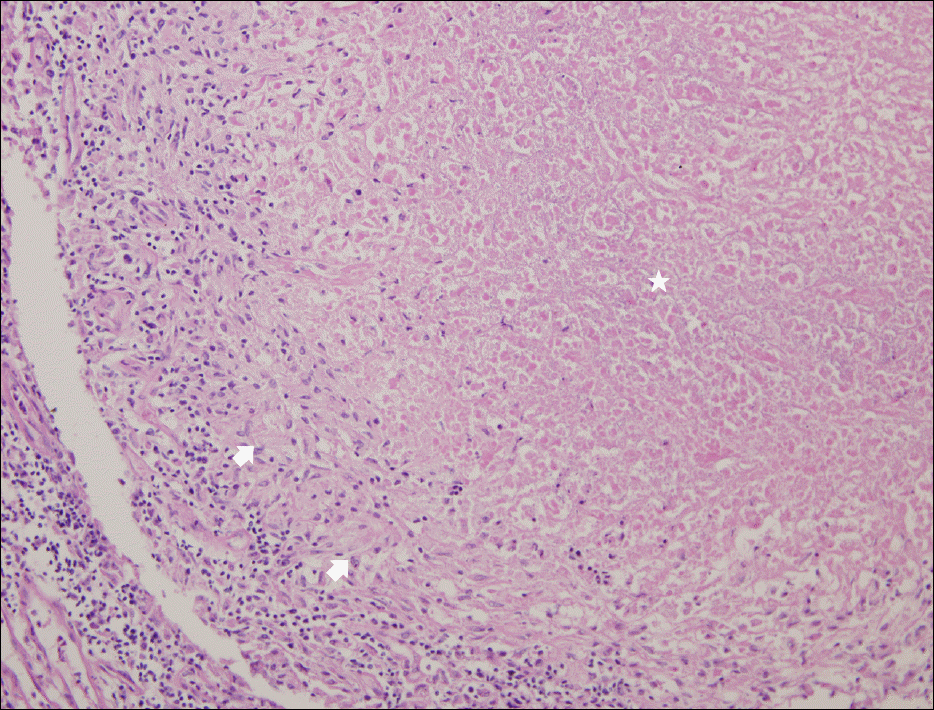Abstract
Paradoxical reaction during antituberculosis therapy is defined as aggravation of preexisting tuberculous lesions or the development of new lesions. A 24-year-old female college student diagnosed with abdominal and pulmonary tuberculosis presented with fever and abdominal pain after having been treated with antituberculosis agents for 4 months. Tuberculous mesenteric lymphadenitis was suspected on abdominal CT scan and enlarged necrotic abscess was also present. These findings were considered to be due to paradoxical reaction rather than treatment failure during antituberculosis treatment. Although laparoscopic bowel adhesiolysis and abscess drainage were performed, high fever and severe abdominal pain did not improve. However, the patient eventually made a completely recovery after corticosteroid therapy combined with antituberculosis agents. Herein, we report a case of paradoxical reaction which developed in a patient with abdominal and pulmonary tuberculosis during antituberculosis therapy.
Go to : 
References
1. Cheng VC, Ho PL, Lee RA, et al. Clinical spectrum of paradoxical deterioration during antituberculosis therapy in non-HIV-in-fected patients. Eur J Clin Microbiol Infect Dis. 2002; 21:803–809.

2. Al-Majed SA. Study of paradoxical response to chemotherapy in tuberculous pleural effusion. Respir Med. 1996; 90:211–214.

3. Hawkey CR, Yap T, Pereira J, et al. Characterization and management of paradoxical upgrading reactions in HIV-uninfected patients with lymph node tuberculosis. Clin Infect Dis. 2005; 40:1368–1371.

4. Cheng VC, Yam WC, Woo PC, et al. Risk factors for development of paradoxical response during antituberculosis therapy in HIV-negative patients. Eur J Clin Microbiol Infect Dis. 2003; 22:597–602.

5. Carvalho AC, De Iaco G, Saleri N, et al. Paradoxical reaction during tuberculosis treatment in HIV-seronegative patients. Clin Infect Dis. 2006; 42:893–895.

6. Blumberg HM, Burman WJ, Chaisson RE, et al. American Thoracic Society, Centers for Disease Control and Prevention and the Infectious Diseases Society. American Thoracic Society/Centers for Disease Control and Prevention/Infectious Diseases Society of America: treatment of tuberculosis. Am J Respir Crit Care Med. 2003; 167:603–662.
7. Ahn TH, Park MB, Lee KJ, et al. A case report of tuberculous brain abscess and tuberculous peritonitis developing due to paradoxical reactions. Tuberc Respir Dis. 2009; 66:457–462.

8. Kasahara K, Fukuoka A, Murakawa K, et al. Tuberculous peritonitis developing during chemotherapy for pulmonary and intestinal tuberculosis: a case report. Respirology. 2005; 10:257–260.

9. Kim SY, Oh TH, Seo JY, et al. A case of tuberculous peritonitis developed during chemotherapy for tuberculous pleurisy as paradoxical response. Korean J Gastroenterol. 2011; 57:379–383.

10. Bukharie H. Paradoxical response to antituberculous drugs: resolution with corticosteroid therapy. Scand J Infect Dis. 2000; 32:96–97.

11. Lee YJ, Jung SH, Hyun WJ, et al. A case of obstructive jaundice caused by paradoxical reaction during antituberculous chemotherapy for abdominal tuberculosis. Gut Liver. 2009; 3:338–342.

12. Dixit R, Nuwal P, Arya M. Splenic abscess as a paradoxical response to chemotherapy in tuberculous pleural effusion. Ann Thorac Med. 2010; 5:50–51.

13. Kim YS, Kim YH, Lee KM, Kim JS, Park YS. IBD Study Group of the Korean Association of the Study of Intestinal Diseases. Diagnostic guideline of intestinal tuberculosis. Korean J Gastroenterol. 2009; 53:177–186.
14. Geri G, Passeron A, Heym B, et al. Paradoxical reactions during treatment of tuberculosis with extrapulmonary manifestations in HIV-negative patients. Infection. 2013; 41:537–543.

15. Kim SH, Chung HY, Lee GD, et al. Clinical characteristics of paradoxical response to chemotherapy in pulmonary tuberculosis. Tuberc Respir Dis. 2002; 53:27–35.

16. Grange JM, Stanford JL, Rook GA. Tuberculosis and cancer: par-allels in host responses and therapeutic approaches? Lancet. 1995; 345:1350–1352.

17. Garcia Vidal C, Garau J. Systemic steroid treatment of paradoxical upgrading reaction in patients with lymph node tuberculosis. Clin Infect Dis. 2005; 41:915–916.
18. Garcia Vidal C, Rodríguez Fernández S, Martínez Lacasa J, et al. Paradoxical response to antituberculous therapy in infliximab- treated patients with disseminated tuberculosis. Clin Infect Dis. 2005; 40:756–759.
Go to : 
 | Fig. 1.Chest CT findings. (A) Chest CT shows ill-defined patchy consolidation and small nodules in the right upper lobe. (B) Four months after initiation of antituberculosis therapy, previous lesion is markedly reduced. |
 | Fig. 2.Abdominal CT findings. (A) About 1-cm sized lymphadenopathy with multiple lymphadenopathies is noted on the ileocecal area (arrow).(B) Four months after initiation of antituberculosis treatment, about 4-cm sized conglomerated lymph node with central necrosis is detected on the ileocecal area (arrow). (C) One month after laparoscopic drainage and adjuctive corticosteroid therapy, the conglomerated mass is reduced (arrow). (D) One year after laparoscopic drainage and adjuctive corticosteroid treatment, the previous lesion is decreased to normal range. |
 | Fig. 3.Colonoscopic and microscopic findings. (A) Exudate covered shallow ulcer is shown on terminal ileum. (B) Presence of chronic granuloma with epithelioid cells (arrows) is compatible with intestinal tuberculosis (H&E stain, ×200). |
 | Fig. 4.Histological finding of peritoneal wall. Peritoneal biopsy shows chronic granulomatous inflammation with epithelioid cell (arrows) and necrosis (asterisk), consistent with tuberculous peritonitis (H&E stain, ×200). |
Table 1.
Clinical Feature of Cases of Abdominal Tuberculosis Developed during Anti-TB Therapy as PR
| Reference | Site of initial involvement | Time to onset of PR (day) | Presentation of PR | Treatment (duration or dose) | Outcome |
|---|---|---|---|---|---|
| Cheng et al.4 | Lung, cervical and mediastinal LN | 56 | Sudden onset of acute abdominal pain, vomiting; CT showed thickening of wall of terminal ileum. | Continuation of anti-TB therapy | Recovery |
| Pelvic, peritoneum, paravertebral abscess at right-sided T6 and left-sided T8-10 | 32 | Acute abdominal pain; Urgent laparotomy revealed multiple ulcers over small bowel, multiple mesenteric lymph nodes, abscess cavity over pelvis with pus. | Laparotomy with small bowel resection and drainage of intra-abdominal pus | Recovery | |
| Ahn et al.7,a | Lung, pleura | 150 | Acute abdominal pain; CT showed irregular peritoneal line and ascites and abscess. | Abscess drainage Continuation of anti-TB therapy (19 mo) Steroidb | Recovery |
| Kasahara et al.8 | Lung, terminal ileum | 150 | Abdominal distension; CT showed ascites, calcification of LN. | Continuation of anti-TB therapy (12 mo) Operation c | Recovery |
| Kim et al.9 | Pleura | 60 | Acute abdominal pain; CT showed ascites, smudge pattern of peritoneum. | Continuation of anti-TB therapy (9 mo) | Recovery |
| Bukharie10 | Mesenteric LN | 10 | Recurred fever, abdominal pain; CT showed enlargement of previous mass with central necrosis. | Steroid (PRD 60 mg/d for 2 mo) Continuation of anti-TB therapy (10 mo) | Recovery |
| Lee et al.11 | Peritoneum, mesenteric LN, ileocecal valve, colon | 150 | Obstructive jaundice; CT showed compression of CBD due to enlarged LN of periportal area. | Steroid (PRD 30 mg/d for 1 mo) ERBD | Recovery |
| Colonoscopy showed a new ulcer lesion of ascending colon. | Continuation of anti-TB therapy (9 mo) | ||||
| Dixit et al.12 | Pleura | 42 | Gradually left side abdominal pain; CT showed miliary sized abscesses on spleen. | Steroid (PRD 40 mg/d) Continuation of anti-TB therapy (6 mo) | Recovery |




 PDF
PDF ePub
ePub Citation
Citation Print
Print


 XML Download
XML Download